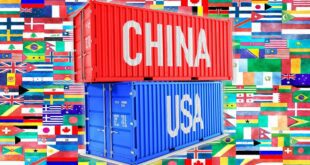Automatically receive the internet’s most informative articles bi-weekly via our free bi-weekly Market Intelligence Report newsletter (sample here). Register in the top right hand corner of this page.
…If we want to better understand the answer to the elusive question of “When will the fiat US dollar collapse?”, we have to watch the petrodollar system and the factors affecting it….This is critically important, because once the dollar loses this coveted status…the destruction of the dollar is going to wipe out the wealth of a lot people, and that will cause political and social consequences that will likely be worse than the financial consequences. @A Financial Site For Sore Eyes & Inquisitive Minds
This article consists of edited [ ] and abbreviated […] excerpts from the original article by Nick Giambruno to provide you with a FASTER – and EASIER – read.
@$$4$ The three points to understand here are:
- You absolutely must be internationalized before the U.S. dollar loses its status as the premier reserve currency. Internationalization is your ultimate insurance policy.
- The U.S. dollar’s status as the premier reserve currency is tied to the petrodollar system.
- The sustainability of the petrodollar system is linked to Middle East geopolitics….@Economic Developments
The Rise & Fall of Bretton Woods
@$Being victorious in WWII and possessing the overwhelmingly largest gold reserves in the world (around 20,000 tonnes) allowed the U.S. to reconstruct the global monetary system with the dollar at its center in what was known as the Bretton Woods international monetary system. Simply put, the Bretton Woods system was an arrangement whereby a country’s currency was tied to the U.S. dollar through a fixed exchange rate, and the U.S. dollar itself was tied to gold at a fixed exchange rate. Countries accumulated dollars in their reserves to engage in international trade or to exchange them with the U.S. government at the official rate for gold ($35 an ounce).
Editor’s Note: Enjoying the article so far? If so, please DONATE a small amount so I can continue to bring you such informative articles.
By the late 1960s, exuberant spending from welfare and warfare, combined with the Federal Reserve monetizing the deficits, drastically increased the number of dollars in circulation in relation to the gold backing it and, naturally, this caused countries to accelerate their exchange of dollars for gold at the official price. The result was a serious drain in the U.S. gold supply (20,000 tonnes at the end of WWII to around 8,100 tonnes in 1971, a figure supposedly held constant to this day) so, on August 15, 1971, Nixon officially ended convertibility of the dollar for gold to halt the gold outflow. The U.S. defaulting on its promise to back the dollar with gold ended the Bretton Woods system.
The central justification that the gold–backed dollar had provided as to why countries held the dollar in their reserves and used it as a medium of international trade was now gone. With the dollar no longer convertible into gold, demand for dollars by foreign nations was sure to fall and with it, its purchasing power.
The Advent of the Petrodollar
OPEC passed numerous resolutions after the end of Bretton Woods, stating the need to retain the real value of its earnings (including discussions about accepting gold for oil), which resulted in the cartel significantly increasing the nominal dollar price of oil in the wake of August 15, 1971.
If the dollar was to sustain its status as the world’s reserve currency, a new arrangement would have to be constructed to give foreign countries a compelling reason to hold and use dollars and Nixon and Kissinger succeeded in retaining the dollar’s premier status by bridging the gap between the failed Bretton Woods system and the emerging petrodollar system.
Between the years of 1972 to 1974 the U.S. government completed a series of agreements with Saudi Arabia to create the petrodollar system. Saudi Arabia was chosen because of its vast petroleum reserves, its dominant influence in OPEC, and the (correct) perception that the Saudi royal family was corruptible.
In essence, the petrodollar system was an agreement that, in exchange for the U.S. guaranteeing the survival of the House of Saud regime by providing a total commitment to its political and security support, Saudi Arabia would:
- Use its dominant influence in OPEC to ensure that all oil transactions would be conducted only in U.S. dollars.
- Invest a large amount of its dollars from oil revenue in US Treasury securities and use the interest payments from those securities to pay U.S. companies to modernize the infrastructure of Saudi Arabia.
- Guarantee the price of oil within limits acceptable to the U.S. and act to prevent another oil embargo by other OPEC members.
The Importance of the Petrodollar System
The need to use dollars to transact in oil, the world’s most traded and most strategic commodity, provides a very compelling reason for foreign countries to keep dollars in their reserves. For example, if Italy wants to buy oil from Kuwait, it has to first purchase U.S. dollars on the foreign exchange market to pay for the oil, thus creating an artificial market for U.S. dollars that would not have otherwise naturally existed. This demand is artificial, since the U.S. dollar is just a middleman in a transaction that has nothing to do with a U.S. product or service. It ultimately translates into:
- increased purchasing power and a deeper, more liquid market for the U.S. dollar and Treasuries…and
- the unique privilege of the U.S. not having to use foreign currency but rather using its own currency, which it can print, to purchase its imports, including oil.
The benefits of the petrodollar system to the U.S. dollar are indeed difficult to overstate.
The Weakening of the Petrodollar System
The geopolitical sands of the Middle East have been rapidly shifting as evidenced by:
- The faltering strategic regional position of Saudi Arabia,
- the rise of Iran which is notably not part of the petrodollar system,
- failed U.S. interventions, and
- the emergence of the BRICS countries providing potential future alternative economic/security arrangements
and all affect the sustainability of the petrodollar system.
The relationship between the U.S. and Saudi Arabia is deteriorating. The Saudis are furious at what they perceive to be the U.S. not holding up its part of the petrodollar deal. They believe that, as part of the U.S. commitment to keep the region safe for the monarchy, the U.S. should have attacked their regional rivals, Syria and Iran, by now. This would suggest that they may feel that they are no longer obliged to uphold their part of the deal, namely selling their oil only in U.S. dollars.
The Saudis have even gone so far as to suggest a “major shift” is underway in their relations with the U.S.. To date, though, they have yet to match actions to their words, which suggests it may just be a temper tantrum or a bluff. In any case, it is truly unprecedented language and merits further watching. A turning point may really be reached when you start hearing U.S. officials expounding on the need to transform the monarchy in Saudi Arabia into a “democracy” but don’t count on that happening as long as their oil is flowing only for U.S. dollars.
Conclusion
It was evident long before Nixon closed the gold window and ended the Bretton Woods system on August 15, 1971, that a paradigm shift in the global monetary system was inevitable. Likewise today, a paradigm shift in the global monetary system also seems inevitable.
By considering Ron Paul’s words, “We will know that day is approaching when oil-producing countries demand gold, or its equivalent, for their oil rather than dollars or euros” we will know when the dollar collapse is imminent.
 munKNEE.com Your Key to Making Money
munKNEE.com Your Key to Making Money


